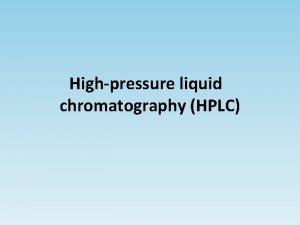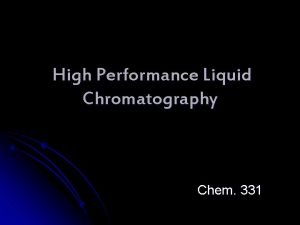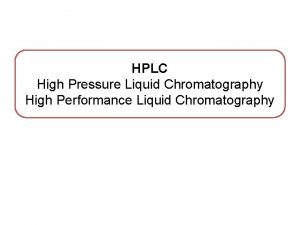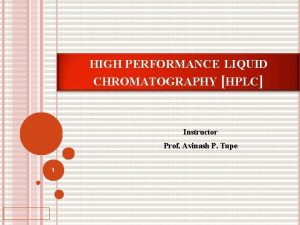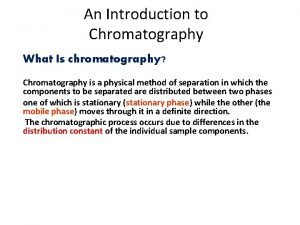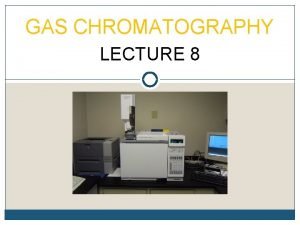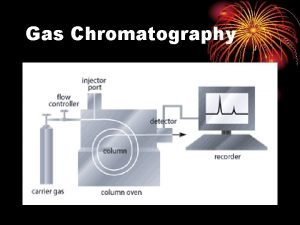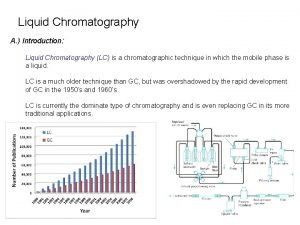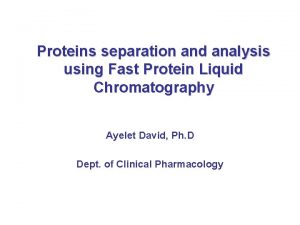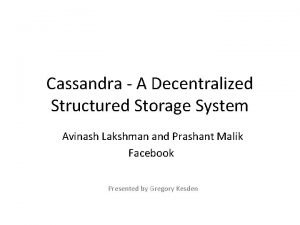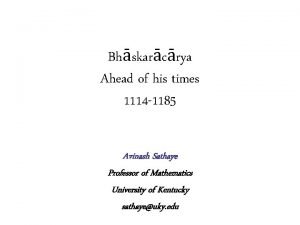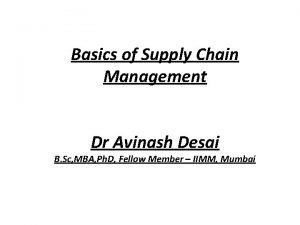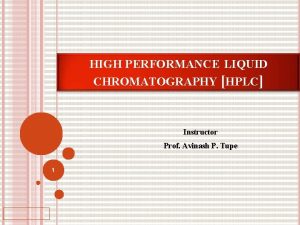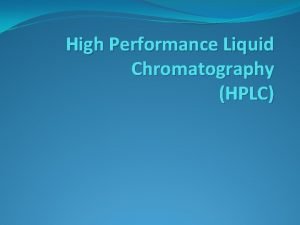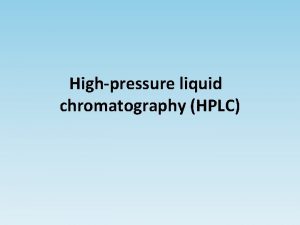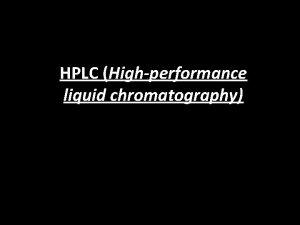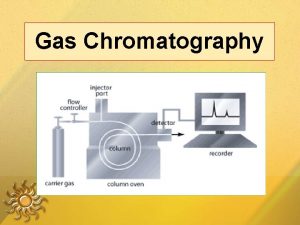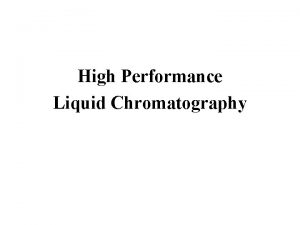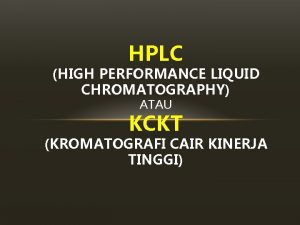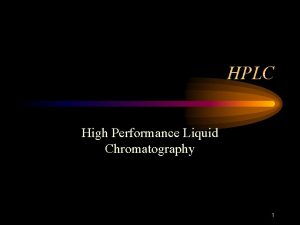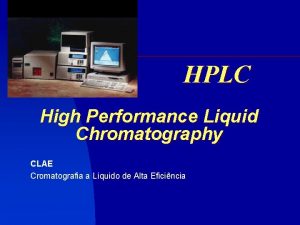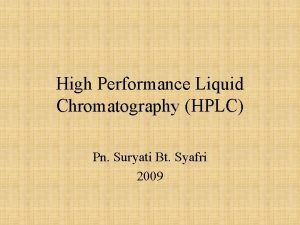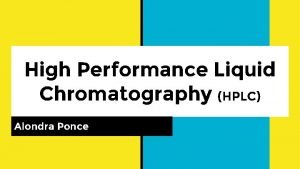HIGH PERFORMANCE LIQUID CHROMATOGRAPHY HPLC Instructor Prof Avinash
![HIGH PERFORMANCE LIQUID CHROMATOGRAPHY [HPLC] Instructor Prof. Avinash P. Tupe 1 HIGH PERFORMANCE LIQUID CHROMATOGRAPHY [HPLC] Instructor Prof. Avinash P. Tupe 1](https://slidetodoc.com/presentation_image_h2/5cd6f911225fc2bbf5317126014ecac7/image-1.jpg)







![PRINCIPLE High Performance Liquid Chromatography [HPLC] principle is based on adsorption as well as PRINCIPLE High Performance Liquid Chromatography [HPLC] principle is based on adsorption as well as](https://slidetodoc.com/presentation_image_h2/5cd6f911225fc2bbf5317126014ecac7/image-9.jpg)






- Slides: 15
![HIGH PERFORMANCE LIQUID CHROMATOGRAPHY HPLC Instructor Prof Avinash P Tupe 1 HIGH PERFORMANCE LIQUID CHROMATOGRAPHY [HPLC] Instructor Prof. Avinash P. Tupe 1](https://slidetodoc.com/presentation_image_h2/5cd6f911225fc2bbf5317126014ecac7/image-1.jpg)
HIGH PERFORMANCE LIQUID CHROMATOGRAPHY [HPLC] Instructor Prof. Avinash P. Tupe 1

Learning Outcomes 1) Define Chromatography 2) State different types of Chromatographic Techniques. 3) State Principle behind the Liquid chromatography 4) Define HPLC. 5) State Principle behind the HPLC technique.

CHROMATOGRAPHY It is define as, it is analytical method in which separation of active constituent in complex mixture, and the mixture was distributed in two phases i. e. stationary phase and mobile phase is known as chromatography. It is a technique used for separation, purification, Identificationand extraction of compound. It is a method it can consist of two phases stationary phase and mobile phase. Stationary phase is constant phase or column packaging material. Mobile phase is moveable phase. The basic principle of chromatography is based on Adsorption and partition chromatography. Adsorption chromatography - The affinity of molecules towards stationary phase is known as Adsorption chromatography. Partition chromatography - The molecule can moves in two phases of liquid is known as partition chromatography. It is important for qualitative and quantitative analysis. 2

TYPES OF CHROMATOGRAPHY Based on modes of chromatography 1. Normal phase mode 2. Reverse phase mode Based on principle of separation 1. Adsorption chromatography 2. Ion exchange chromatography 3. Partition chromatography 4. Size exclusion Based on elution technique 1. Isocratic separation 2. Gradient separation Based on the scale of operation 1. Analytical HPLC 2. Preparative HPLC Based on the type of analysis 1. Qualitative analysis 2. Quantitative analysis 3

PRINCIPLES OF LIQUID CHROMATOGRAPHY 5

TYPES OF LIQUID CHROMATOGRAPHY 6

HPLC is a High Performance liquid Chromatography. High Pressure Liquid Chromatography. High Priced Liquid Chromatography. It is column chromatography. It is Liquid Chromatography. It is modified from of gas chromatography, it is applicable for both Volatile as well as Non volatile compound. It can mainly divided by two types 1. Normal phase HPLC 2. Reversed Phase HPLC. It is having a high resolution and separation capacity. It is used as qualitative as well as quantitative analysis. High performance liquid chromatography (HPLC) is a chromatographic technique used to separate a mixture of compounds in analytical chemistry and biochemistry with the purpose of identifying, quantifying or purifying the individual components of the mixture. 7

7
![PRINCIPLE High Performance Liquid Chromatography HPLC principle is based on adsorption as well as PRINCIPLE High Performance Liquid Chromatography [HPLC] principle is based on adsorption as well as](https://slidetodoc.com/presentation_image_h2/5cd6f911225fc2bbf5317126014ecac7/image-9.jpg)
PRINCIPLE High Performance Liquid Chromatography [HPLC] principle is based on adsorption as well as partition chromatography is depending on the nature of stationary phase, if stationary phase is solid principle is based on adsorption chromatography and if stationary phase is liquid principle is based on partition chromatography. It is important for determination of volatile and non volatile compounds. It is important for determination qualitative and quantitative analysis. It is important for determination of Retention Time (the time is required , after sample injection maximum angle peak reaches to detector) 8

9

ADVANTAGES It is simple, rapid , reproducible. High sensitivity. High performance. Rapid process and hence time saving. It is having a high resolution and separation capacity. Accuracy and Precision. Stationary phase was chemically inert. Wide varities of stationary phase. Mobile phase was chemically inert. Less requirement of mobile phase in developing chamber. Early recovery of separated component. Easy visualization of separated components. It is having Good reproducibility and repeatability. It is an analytical technique which is important for validation of product, quality control studies of product. It is important for qualitative and quantitative analysis. 10 It is used for both analytical and preparative purpose.

TYPES OF HPLC SEPARATIONS Normal Phase: Separation of polar analytes by partitioning onto a polar, bonded stationary phase. Reversed Phase: Separation of non-polar analytes by partitioning onto a non-polar, bonded stationary phase. Adsorption: In Between Normal and Reversed. Separation of moderately polar analytes using adsorption onto a pure stationary phase (e. g. alumina or silica) Ion Chromatography: Separation of organic and inorganic ions by their partitioning onto ionic stationary phases bonded to a solid support. Size Exclusion Chromatography: Separation of large molecules based in the paths they take through a “maze” of tunnels in the stationary phase. 12

HPLC METHODS Parameter Group Method Compounds • SDW 05. 23000’s • WPP 05. 06000’s EPA 555 Cl-Phenoxy. Acids EPA 605 Benzidines • • WPP 05. 13000’s EPA 610 PAHs SHW 06. 26000’s SW-846 8316 Acrylics • SHW 06. 28000’s SW-846 8330’s Explosives SW-846 8325 Benzidines and N- Pesticides • SHW 07. 06000’s 13

HPLC CONTAIN Stationary Phase - It is non polar and The stationary solid surface is coated with a 2 nd liquid (the Stationary Phase) which is immiscible with mobile phase. Mobile Phase - A polar mobile phase(ACN, Me. OH, WATER + BUFFER). Bonded Phases C-2 Ethyl Silyl -Si-CH 2 -CH 3 • C-8 Octyl Silyl -Si-(CH 2)7 -CH 3 • C-18 Octadecyl Silyl -Si-(CH 2)17 -CH 3 • CN Cyanopropyl Silyl -Si-(CH 2)3 -CN 14

65
 High performance liquid chromatography hplc machine
High performance liquid chromatography hplc machine Application of chromatography
Application of chromatography High performance liquid chromatography introduction
High performance liquid chromatography introduction Hplc vs gas chromatography
Hplc vs gas chromatography Hplc chromatography principle
Hplc chromatography principle Mobile phase in adsorption chromatography
Mobile phase in adsorption chromatography Principle of gc
Principle of gc Gas liquid chromatography
Gas liquid chromatography Partition chromatography
Partition chromatography What is void volume in gel filtration
What is void volume in gel filtration Avinash kalyanaraman
Avinash kalyanaraman Prashant malik cassandra
Prashant malik cassandra Aea continuing education
Aea continuing education S66can
S66can Avinash sathaye
Avinash sathaye Dr avinash desai
Dr avinash desai

